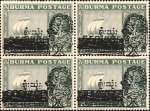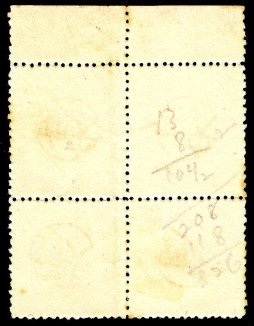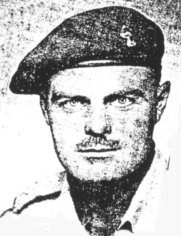 One humble but intriguing oddity of Burma philately is the 1964 “local” official overprint on the 3p definitive, reading “Service” in English (SG O174, Scott O80). Given that every other such overprint since Independence had been in Burmese, this appeared distinctly anomalous at the time, and the stamp’s status was questioned when examples leaked into the wider philatelic view, mainly courtesy of the enigmatic Mr D V George, an employee at the Accountant-General’s Department in Rangoon. Mr George seems to have saved scrupulously every cover with a copy of the stamp that went anywhere near his desk; it’s highly unusual to see a cover with this stamp addressed to anywhere else.
One humble but intriguing oddity of Burma philately is the 1964 “local” official overprint on the 3p definitive, reading “Service” in English (SG O174, Scott O80). Given that every other such overprint since Independence had been in Burmese, this appeared distinctly anomalous at the time, and the stamp’s status was questioned when examples leaked into the wider philatelic view, mainly courtesy of the enigmatic Mr D V George, an employee at the Accountant-General’s Department in Rangoon. Mr George seems to have saved scrupulously every cover with a copy of the stamp that went anywhere near his desk; it’s highly unusual to see a cover with this stamp addressed to anywhere else.

George proceeded to alert Gibbons Stamp Monthly, who made enquiries of the Burma postal authorities, but at first drew a blank. Not until early 1966, well over a year after the stamp’s first appearance, was it finally acknowledged by the Burma post office as “officially authorised”. Covers and used copies are largely from Meiktila and Mindat, with Tavoy and Kyauktu bringing up the rear; commercial use is known from January 1965 until late 1966, with a handful (some possibly philatelic) after that. Distribution, designed to alleviate shortages of the regular overprint on this value, was clearly specific and limited.
Stamps overprinted for official use were only available to government bodies from the Treasury department, and could not be bought by the public from post offices. So neither stamps nor covers are exactly common, and the survivors must surely account for only a fraction of the 160,000 copies said to have been overprinted. Gibbons price this stamp at under £10 mint and a mere £6.50 used; in fact its catalogue value has fallen since the 2004 “Part 21” was published. However, it can change hands on eBay and elsewhere for more than this, and its scarcity has now – as far as I know for the first time – been noticed by forgers.
Here (above) is an example of the forgery, acquired recently in a Bangkok stamp shop. Since this version of the overprint does not seem to have been recorded before, and as it differs from every example of the known stamp that I’ve ever seen, it seems fair to declare it a forgery. It’s not a bad imitation, but comparison with the genuine overprint shows that the letters in the forgery are more widely spaced; D V George claimed to have found a “variety” of the original with the “v” and “i” joined, though to my mind this may have been no more than migrating ink – but that does serve to demonstrate the close spacing of the real overprint. In addition, in the forgery the difference between the broad and narrow strokes of each letter seems more pronounced, the “S” is more upright, the “v” is slightly elevated, and the top of the “i” appears to slope, while on the real stamp it is level.

The genuine measures just over 10 mm, while the forgery is nearer to 11 mm. Though the forgery appears to be typographed, the impression of the letters is not at all so pronounced on the back of the stamp as it is on the genuine. As the centering of the basic stamp on the two copies seen is very different, it may be that this forged overprint has been applied to single stamps or small multiples, and not to sheets or large blocks.
So far, this forgery does not seem to have circulated too widely, and let’s hope it stays that way. My grateful thanks go to Kevin Tse for telling me about this, and for very kindly making available an example.



























